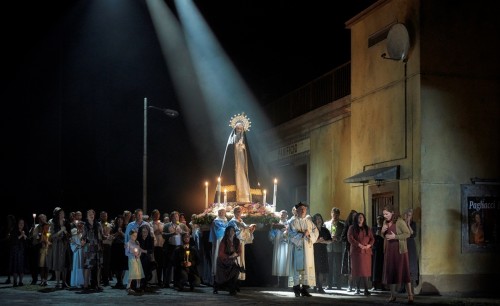 Sweden Mascagni, Cavalleria rusticana and Leoncavallo, Pagliacci: Soloists and Chorus of Gothenburg Opera, extra chorus, Gothenburg Opera Orchestra / Pier Giorgio Morandi (conductor), Gothenburg Opera, 9.2.2019. (NS)
Sweden Mascagni, Cavalleria rusticana and Leoncavallo, Pagliacci: Soloists and Chorus of Gothenburg Opera, extra chorus, Gothenburg Opera Orchestra / Pier Giorgio Morandi (conductor), Gothenburg Opera, 9.2.2019. (NS)

Production:
Director original production – Damiano Michieletto
Director revival production – Rodula Gaitanou
Set design – Paolo Fantin
Costume design – Carla Teti
Lighting design – Alessandro Carletti
Cavalleria Rusticana
Cast:
Santuzza – Annalena Persson
Turiddu – Joachim Bäckström
Mamma Lucia – Rosalind Plowright
Alfio – Åke Zetterström
Lola – Ann-Kristin Jones
Pagliacci
Cast:
Canio – Tomas Lind
Nedda – Carolina Sandgren
Tonio – Mats Persson
Beppe – Markus Pettersson
Silvio – Luthando Qave
Two villagers – Mikael Simlund, Dardan Bakraqi
Having already been revived once at Covent Garden, Damiano Michieletto’s production of this classic verismo double bill has made its way to Gothenburg. The concept is that the events of the two operas happen in the same dusty southern Italian town within a short time. Indeed, the casts make appearances in each other’s operas, most obviously Silvio (Luthando Qave) who has a significant if silent role as a baker in Cavalleria rusticana. Here he meets Nedda for the first time (the commedia dell’arte troupe are already in town) and they share their first kiss during Mascagni’s beautiful intermezzo.
Paolo Fantin’s sets emphasise kitchen sink realism and make creative use of a turntable to provide seamless scene changes. Cavalleria rusticana is set in and around Mamma Lucia’s bakery and the town square it faces, but in practice only two sides of the set are used. Pagliacci is set in the same town’s parish hall, a much more creatively designed set that effectively has four sides all of which are used and integrated into the action. For me the Pagliacci set was also better acoustically.
This concept works and together with revival director Rodula Gaitanou’s skills made for a very dramatic experience with great acting and scenic use of the chorus who are so essential to the plots of both operas. However, I think Mr Michieletto erred when he decided to interpret Cavalleria rusticana as having the inevitability of a Greek tragedy, most of all by having the final tableau of the villagers surround Turiddu’s dead body at the beginning of the opera as well, where it jarred against Turiddu’s beautiful offstage siciliana.
The casting of Cavalleria rusticana was a bit uneven. Joachim Bäckström impressed from the start as Turiddu, able to project a beautiful tenor sound in the siciliana, but also passionately expressive in his confrontations with Santuzza and Alfio, and a haunting farewell to his mother in ‘Mamma, quel vino è generoso’. Rosalind Plowright was equally moving as Mamma Lucia. Ann-Kristin Jones was sultry, seductive and flirtatious as Lola – and that was just her voice! She also had great stage presence, clearly showing that Lola and Turiddu are birds of a feather: both are impulsive and hedonistic, with dreadful consequences.
Annalena Persson gave a gripping portrait of a woman at the end of her tether as Santuzza, but she has developed a wide vibrato that was rather obtrusive in Santuzza’s solos. The vibrato was however less bothersome in Santuzza’s confrontations with other characters, and her voice soared over the chorus in the magnificent Easter Hymn. Åke Zetterström’s refined and agile baritone worked well when Alfio was playing the role of top man in local society, but it lacked the darkness to reflect Alfio’s aura of danger. That said there was plenty of darkness in Mr Zetterström’s acting, most of all in his withering contempt of Turiddu when they confront each other before the duel.
I have no reservations about the casting for Pagliacci. Mats Persson set a high standard immediately in the Prologue ‘Si può? Si può?’ which felt straight from the heart. He then excelled as a sinisterly manipulative Tonio, darkening the colour of his voice to match his acting. Markus Pettersson demonstrated an attractive tenor as Beppe and in particular when he was in character as Harlequin.
Carolina Sandgren (substituting for Ida Falk Winland, who had a cold) enchanted as Nedda from her first aria ‘Stridono lassù’. She movingly expressed both Nedda’s fear of her pathologically controlling husband and her bravery in defying him. Silvio (Luthando Qave) sang with a warm baritone that made for a lovely duet with Nedda.
Tomas Lind gave a terrific performance as Canio. He was in fine voice and acted convincingly as an older man consumed by jealousy. ‘Vesti la giubba’ was gripping, as were his confrontations with Nedda and a cleverly envisioned spiralling loss of control as he hears the play from the wings and the boundary between fact and fiction blurs.
The Gothenburg Opera Chorus never gave less than their best in both operas. The acted as individuals, bringing a real sense of an Italian village community on to the stage. They sang their hearts out, but always in the right balance with the soloists and the orchestra. Pier Giorgio Morandi’s conducting and the orchestra’s playing were top class, sensitive both to the singers and to the arc of the drama. He brought out the beauty of much of the Mascagni and Leoncavallo’s music without letting that get in the way of the story. He richly deserved the rare honour of a touche fanfare from the Gothenburg Opera Orchestra.
Niklas Smith
Playing until 31 March 2019. Katerina Karnéus sings Santuzza instead of Annalena Persson on 23, 29 and 31 March. These dates are also when Carolina Sandgren is scheduled to sing Nedda; Ida Falk Winland is scheduled for the rest of the run. See the Gothenburg Opera website.
